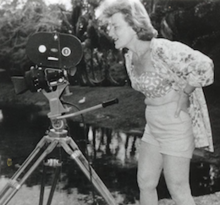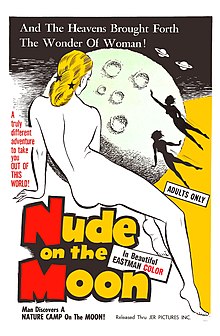Doris Wishman
Doris Wishman | |
|---|---|
 Wishman on a film set, c. 1960s | |
| Born | June 1, 1912 New York City, U.S. |
| Died | August 10, 2002 (aged 90) |
| Alma mater | Hunter College |
| Occupation(s) | Director, producer, writer |
| Years active | 1959–2002 |
| Spouse | Jack Abrams (d. 1958) |
Doris Wishman (June 1, 1912 – August 10, 2002) was an American film director, screenwriter, and producer. She is credited with having directed and produced at least 30 feature films during a career spanning over four decades, most notably in the
A native of New York City, Wishman began her film career as a hobby after the death of her husband in 1958. She made her feature debut with Hideout in the Sun (1960), and went on to direct numerous nudist and sexploitation films, such as Gentlemen Prefer Nature Girls (1963), Behind the Nudist Curtain (1963), and Bad Girls Go to Hell (1965). In the 1970s, she made her first foray into directing pornographic films.
In 1979, Wishman filmed her first and only feature horror film, A Night to Dismember, which she spent several years editing after multiple reels were destroyed during post-production.[1] She made a further three films in the early 2000s before dying in 2002, aged 90.
Life and career
Early life
Doris Wishman was born on June 1, 1912, in New York City,[2] the daughter of Ukrainian-Jewish immigrants.[3] Her father was a hay and grain salesman; her mother died when she was still a child.[4] She was raised in the New York City borough of the Bronx, where she graduated from James Monroe High School. After graduating from high school, Wishman claimed to have taken acting lessons at the Alviene School of Dramatics in New York City in the early 1930s, where she was a classmate of Shelley Winters.[5] She later studied at Hunter College.[2]
She later worked as a film booker for her cousin
Beginnings; nudist films

Her first films are called nudist camp films or nudist romances.
Sexploitation films

Wishman began to produce and direct sex-exploitation or sexploitation features in 1964, which were often called "roughies".[1] Censorship at the time would allow very little, meaning Wishman and other sexploitation directors used different tactics to portray eroticism and excitement, using melodrama, cutaway, soft-core sex talk, and suggestive nudity that just skirted under the law. This put Wishman at odds with censorship law.[8] In this genre, Wishman also used a different style of filmmaking in which she would cut to objects or scenery not in the scene, similar to Soviet montage.[1] Moya Luckett considers that the cutaway style Wishman used was possibly to disrupt male gaze and incorporate a feminine gaze.[8]
Her second release in this genre was Bad Girls Go to Hell (1965), Wishman's first collaboration with her long-time cinematographer C. Davis Smith. During this period, she frequently worked under the pseudonym "Louis Silverman", the name of her second husband. She also directed The Sex Perils of Paulette (1965), which featured Tony Lo Bianco in his film debut.[9] The Sex Perils of Paulette was heavily censored by the New York Censor Board.[8]
All of Wishman's sexploitation work was shot in black and white until the release of her first
Pornographic and later exploitation work
Her work in the 1970s-'80s was all in the soft-core genre of exploitation, except that in the mid-1970s, Wishman directed two
Later life and final films
After the failure of A Night to Dismember, Wishman moved to Coral Gables, Florida, in the mid-1980s, where she found work in an adult-novelty store. Interest in her work began to slowly increase due to the home video release of many of her films through
Death
Wishman died on August 10, 2002, in Miami, Florida, shortly after being treated for lymphoma.[4]
Legacy
Wishman made more films than any other female director of the sound era.
Filmography
| Year | Title | Notes | Ref. |
|---|---|---|---|
| 1960 | Hideout in the Sun | [15] | |
| 1961 | Nude on the Moon | [15] | |
| 1961 | Diary of a Nudist | [15] | |
| 1962 | Blaze Starr Goes Nudist | [16] | |
| 1963 | Gentlemen Prefer Nature Girls | [15] | |
| 1963 | Playgirls International | [17] | |
| 1964 | Behind the Nudist Curtain | [17] | |
| 1964 | The Prince and the Nature Girl | [17] | |
| 1965 | Bad Girls Go to Hell | [18] | |
| 1965 | The Sex Perils of Paulette | [9] | |
| 1966 | Another Day, Another Man | [19] | |
| 1966 | My Brother's Wife | [19] | |
| 1967 | A Taste of Flesh | [20] | |
| 1967 | Indecent Desires | [21] | |
| 1968 | Too Much Too Often! | [21] | |
| 1968 | Love Toy | [2] | |
| 1970 | The Amazing Transplant | [10] | |
| 1972 | Keyholes Are for Peeping | Also known as: Is There Love After Marriage?[7] | [10] |
| 1973 | Deadly Weapons | [22] | |
| 1974 | Double Agent 73 | [22] | |
| 1975 | The Immoral Three | [23] | |
| 1975 | Satan Was a Lady | [24] | |
| 1976 | Come with Me, My Love | Also known as: The Haunted Pussy | [10] |
| 1978 | Let Me Die a Woman | [25] | |
| 1983 | A Night to Dismember | Filmed in 1979 | [11] |
| 2001 | Satan Was a Lady | Differs from 1975 film, but uses same title | [24] |
| 2002 | Dildo Heaven | [24] | |
| 2007 | Each Time I Kill | Released posthumously | [24] |
See also
References
- ^ S2CID 167384493– via Project MUSE.
- ^ a b c d e f g Oliver, Myrna (August 21, 2002). "Doris Wishman; Exploitation Film Director, Cult Favorite". Los Angeles Times. p. B12 – via Newspapers.com.

- ^ Gorfinkel, Elena. "Who's afraid of Doris Wishman?". Artforum. Archived from the original on June 26, 2023.
- ^ a b c d e Martin, Douglas (August 19, 2002). "Doris Wishman, 'B' Film Director, Dies". The New York Times.
- ^ Faust, M. (January 18, 2017). "The Singular Doris Wishman". The Daily Public. Retrieved August 11, 2018.
- ^ "Max Rosenberg". The Telegraph. Obituaries. June 18, 2004. Retrieved August 10, 2018.
- ^ a b c d e Leavold, Andrew (2002). "Bad Girls Go to Dildo Heaven: An All Nude Tribute to Doris Wishman". Sense of Cinema. 23 – via MacOdrum Library.
- ^ a b c d e Gorfinkel, Elena (2008). Indecent Desires: Sexploitation Cinema, 1960's Film Culture and the Adult Film Audience (PhD). New York University. pp. 1–477.
- ^ a b c Quarles 2001, p. 147.
- ^ a b c d e McKendry 2010, p. 60.
- ^ a b McKendry 2010, p. 62.
- ^ Late Night with Conan O'Brien. Season 9. Episode 84. March 7, 2002. NBC.
- ^ Mendik & Schneider 2003, p. 112.
- ^ Mendik & Schneider 2003, p. 116.
- ^ a b c d Geltzer 2016, p. 175.
- ^ Shteir 2004, p. 320.
- ^ a b c Jancovich et al. 2003, p. 143.
- ^ Jancovich et al. 2003, p. 145.
- ^ a b Jancovich et al. 2003, p. 146.
- ^ Beldin, Fred. "A Taste of Flesh (1967)". AllMovie. Retrieved August 10, 2018.
- ^ a b Jancovich et al. 2003, p. 151.
- ^ a b McKendry 2010, p. 61.
- ^ Firsching, Robert. "The Immoral Three". AllMovie. Retrieved August 10, 2018.
- ^ a b c d McKendry 2010, p. 63.
- ^ Jancovich et al. 2003, p. 152.
Works cited
- Geltzer, Jeremy (2016). Dirty Words and Filthy Pictures: Film and the First Amendment. Austin, Texas: University of Texas Press. ISBN 978-1-477-30743-4.
- Jancovich, Mark; Reboli, Antonio Lázaro; Stringer, Julian; Willis, Andrew (2003). Defining Cult Movies: The Cultural Politics of Oppositional Tastes. Manchester: Manchester University Press. ISBN 978-0-719-06631-3.
- Kozma, Alicia; Freibert, Finley, eds. (2023). The Films of Doris Wishman. JSTOR 10.3366/j.ctv1vtz83z.
ReFocus: The American Directors Series
- McKendry, Rebecca (2010). "Fondling Your Eyeballs: Watching Doris Wishman". In Cline, John; Weiner, Robert G. (eds.). From the Arthouse to the Grindhouse: Highbrow and Lowbrow Transgression in Cinema's First Century. Lanham, Maryland: Scarecrow Press. pp. 57–74. ISBN 978-0-810-87655-2.
- ISBN 978-0-231-85002-5.
- Murray, Raymond (1998). Images in the Dark: An Encyclopedia of Gay and Lesbian Film and Video. London: Titan Books. ISBN 978-1-840-23033-8.
- Quarles, Mike (2001). Down and Dirty: Hollywood's Exploitation Filmmakers and Their Movies. Jefferson, North Carolina: McFarland. ISBN 978-0-786-46257-5.
- Shteir, Rachel (2004). Striptease: The Untold History of the Girlie Show. Oxford: Oxford University Press. ISBN 978-0-195-30076-5.
External links
- Doris Wishman at IMDb
- Doris Wishman at AllMovie
- Senses of Cinema: Great Directors Critical Database
- Ironic Mr Fox John Michael McCarthy's memoire of meeting Doris Wishman at the 1998 New York Underground Film Festival featuring original stills. May 30, 2013
